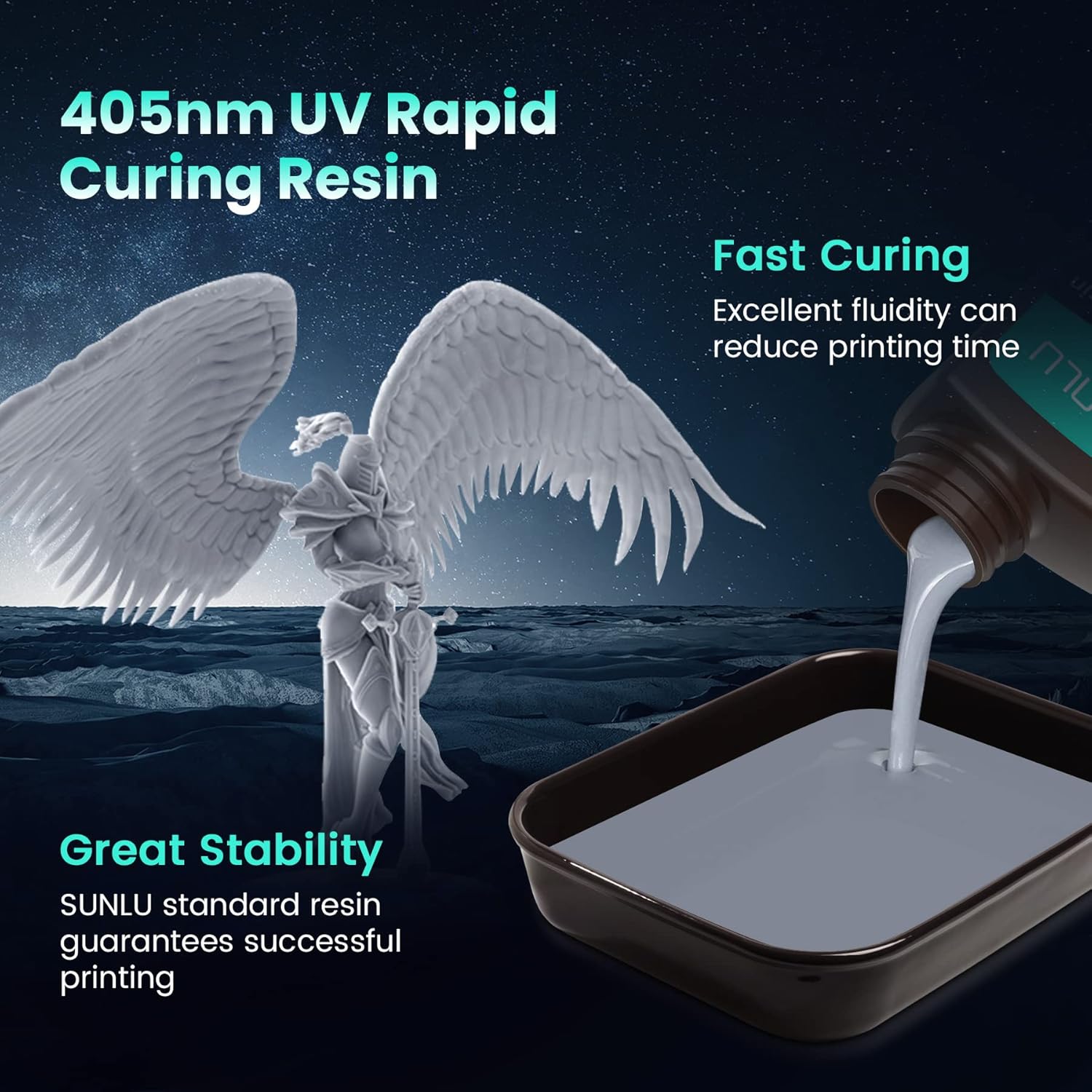Page Contents
Details: SUNLU 3D Printer Resin 1KG, 405nm UV Curing Standard Photopolymer Rapid Resin for 4K/8K LCD/DLP/SLA 3D Printing, High Precision, Low Shrinkage, Clear Red 1000g
Brand: SUNLU
SUNLU 3D Printer Resin 1KG, 405nm UV Curing Standard Photopolymer Rapid Resin for LCD/DLP/SLA 3D Printing.
Advantages
- Products can be returned
- Make sure this fits by entering your model number.
- ①【405nm UV Curing Resin】SUNLU standard resin has been developed through many tests by engineers, which can guarantee excellent printing stability, perfect molding effect, high precision with smooth finish of 3D printing results.
- ②【Low Shrinkage & High Precision】SUNLU team has improved the formulation, focused on reducing volume shrinkage and increasing molding strength, which ensures SUNLU standard resin’s high precision and good stability.
- ③【Fast Curing & Excellent Fluidity】SUNLU 405nm rapid resin has excellent fluidity for fast curing, making the 3D printing models forming faster and the exposure time shorter.
- ④【High Compatibility & Easy to Use】SUNLU standard resin has excellent printing performance and is suitable for most 4K/8K LCD/DLP/SLA 3D printers. Its excellent stability are friendly to both beginners and advanced users.
Notice
- Is an online purchase
- Delivery may be delayed in some areas.
Buyer Guide 3D Printing Supplies
When shopping for materials for your 3D printer, it’s important to do your homework. 3D printing isn’t cheap, so you’ll want to purchase the best supplies you can.- Consider the 3D printer. Some printers have certain materials that they work best with.
- Consider the material. Some materials work better with certain printers.
- Consider the extruder. Some printers work best with an extruder that is compatible with their materials.
- Consider the PLA/ABS ratio. PLA and ABS have different melting points. Some printers work best with one type of material.
How to choose 3D Printing Supplies
If you are interested in learning more about 3D printing, you may have already started shopping for the materials and tools you’ll need to create the objects you want.- 3D printing is the process by which a three-dimensional object is created one layer at a time. There are six different types of 3D printing materials to choose from:
- The filament: This is the material, such as plastic, metal, or ceramics, that is fed into a 3D printer.
- Thermal resistance: This refers to how resistant a material is to heat. Some materials, such as PLA, are more thermally sensitive.
- The layer thickness: The layer thickness of the material determines how dense the surface can be. The higher the number, the thicker the layer.
- The curing speed: This refers to how long it takes for a material to solidify.
- The bonding strength: This is the ability of the material to stick to itself or to another object.
Stability: This refers to how resistant a material is to warping or shrinking. Some materials, such as ABS, are more elastic.
When choosing your materials, it’s important to consider which items you plan to print. The printing process requires certain materials like resin, which can be toxic and flammable.
In addition to the materials, you will also want to consider the tools you will need. A 3D printer itself can cost several thousand dollars, so it’s important to choose wisely.
- The size of the printer: When choosing a printer, it’s important to consider the size of the object you plan to print.
- The printing speed: Depending on your needs, you may need a faster or slower printer.
- The resolution: The resolution refers to the level of detail you can include in your print.
- The printing volume: The bigger the printer, the more material it can process at a time.
- The filament capacity: If you plan to print bigger objects, you may need a bigger capacity.
How to maintain 3D Printing Supplies
3D printing is a fast-growing industry, and many people with 3D printers are excited to add to their collections. However, 3D printing supplies can be expensive, and you dont want your materials to go to waste. So, how do you keep your materials in good condition?- Keep them organized. Many materials come in resealable bags, and its easy to lose track of whats inside. By storing your materials in resealable bags, youll always have an easy way of seeing whats inside.
- Dont pack them full. Packing materials too full can force the material inside the bag to break apart and warp. So, if youre storing your materials in resealable bags, they should be packed loosely.
- Keep them clean. 3D printers use plastic filament, which tends to be very sticky. When storing or transporting your materials, use a thin layer of vegetable oil to keep them from sticking to each other or to other objects.
- Wash them by hand. Many 3D printers use a heated build plate that melts layers of plastic together. Printed parts can get stuck in this plate, which can damage the 3D printer. So, instead of washing the parts in the washing machine, wash them by hand.
- Oil them regularly. It is a good idea to oil your 3D printers print bed regularly to keep parts from sticking to it.
- Clean them regularly. Cleaning your 3D printers print bed is essential. If you dont clean the print bed regularly, it may become covered with dried, hardened plastic, which can cause parts to get stuck.
- Keep them out of sunlight. UV light can damage or discolor your model parts. So, place your 3D printer in a well-lit, cool area.




